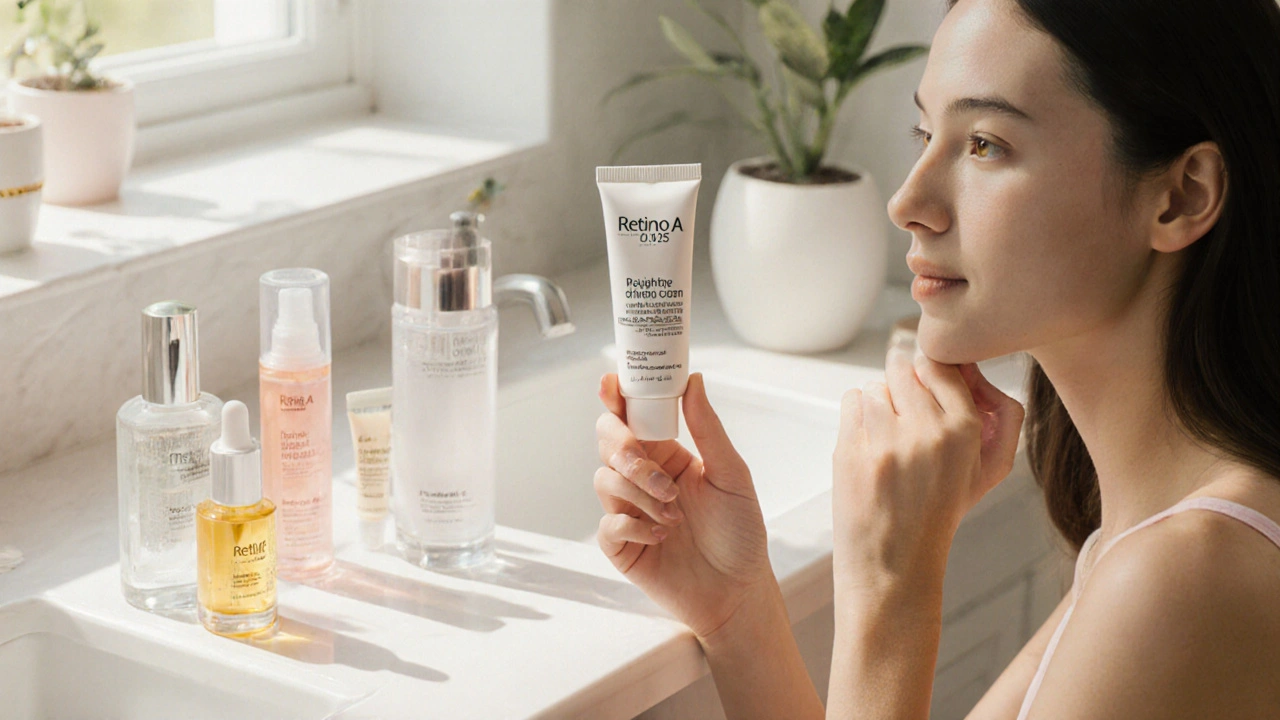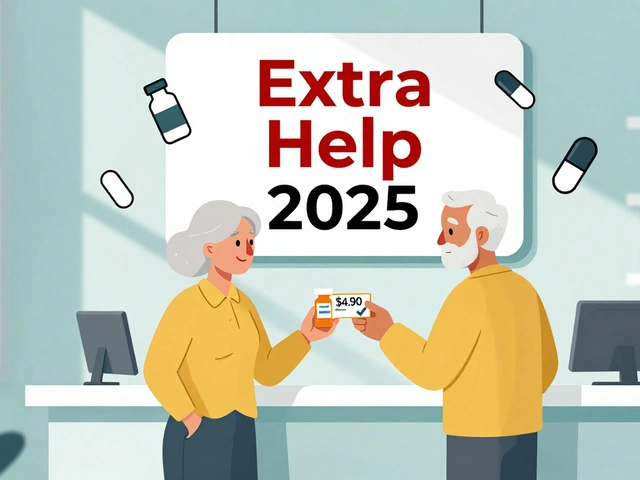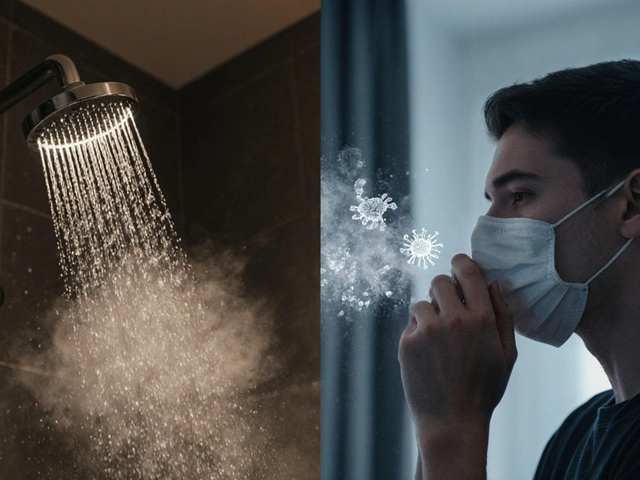Retinoid Choice Advisor
Skin Concerns
Skin Sensitivity
Budget Range
Recommended Retinoid
Retino A Cream 0.025 is a prescription‑strength tretinoin cream (0.025% concentration) that accelerates skin cell turnover, helping clear acne and reduce fine lines. Dermatologists often recommend it for moderate to severe acne and for photo‑aged skin, but it’s not the only retinoid on the market.
Choosing the right retinoid can feel like navigating a maze of brand names, concentrations, and texture claims. This guide breaks down the science, compares the most common alternatives, and gives you a practical checklist so you can stop guessing and start seeing results.
How Retino A Cream 0.025 Works
Tretinoin belongs to the retinoic acid family, a direct derivative of vitamin A. When applied, it binds to nuclear retinoic acid receptors (RAR‑α, RAR‑β, RAR‑γ) and modulates gene expression. The result is increased collagen synthesis, faster shedding of dead skin cells, and a more even melanin distribution. Clinical trials (e.g., a 2022 multicenter study with 452 participants) showed a 57% reduction in inflammatory lesions after 12 weeks of consistent use.
Because the molecule penetrates deep into the epidermis, irritation-dryness, peeling, and mild erythema-is common, especially during the first month. That’s why many users pair Retino A with gentle moisturizers and daily sunscreen.
Top Retinoid Alternatives
Below are the most frequently prescribed or over‑the‑counter rivals. Each entry includes the key attributes that affect efficacy, tolerability, and cost.
Differin Gel is an adapalene 0.1% gel approved for acne. It’s a synthetic retinoid that works similarly to tretinoin but is generally less irritating, making it a popular starter.
Retin‑A Micro is a microsphere‑encapsulated tretinoin 0.04% cream designed for gradual release, which reduces the intensity of side‑effects while maintaining potency.
Tazorac contains tazarotene 0.05% cream or gel, a third‑generation retinoid that’s stronger than tretinoin but also more drying; it’s often chosen for severe psoriasis and stubborn acne.
Prescription Retinoid Cream (generic tretinoin) is a flexible strength (0.01%-0.1%) cream that can be tailored by a dermatologist to match the patient’s tolerance.
Retinol is an over‑the‑counter vitamin A alcohol that the skin converts to tretinoin in small amounts, offering milder results with virtually no prescription required.
Azelaic Acid is a 10%-20% topical acid that isn’t a retinoid but provides anti‑inflammatory and keratolytic benefits similar to low‑dose tretinoin, often used for rosacea‑prone acne.
Vitamin C Serum is a L‑ascorbic acid formulation (usually 15%-20%) that brightens skin and supports collagen synthesis, frequently paired with retinoids for synergistic anti‑aging effects.
Niacinamide is a 5%-10% topical form of vitamin B3 that improves barrier function and reduces redness, making retinoid regimens more tolerable.
Quick‑Look Comparison Table
| Product | Active Ingredient / Strength | Formulation | Typical Indication | Irritation Risk | Average Monthly Cost (USD) |
|---|---|---|---|---|---|
| Retino A Cream 0.025 | Tretinoin 0.025% | Cream | Acne, photo‑aging | Medium‑High | ≈$60 |
| Differin Gel | Adapalene 0.1% | Gel | Mild‑moderate acne | Low‑Medium | ≈$30 (OTC) |
| Retin‑A Micro | Tretinoin 0.04% | Microsphere cream | Acne, fine lines | Low‑Medium | ≈$80 |
| Tazorac | Tazarotene 0.05% | Gel or cream | Severe acne, psoriasis | High | ≈$95 |
| Generic Tretinoin | Varies 0.01%-0.1% | Cream or gel | Tailored acne/aging | Variable | ≈$20-$70 |
| Retinol | Retinol 0.5%-1% | Serum or cream | Mild anti‑aging | Low | ≈$25 |
| Azelaic Acid | Azelaic Acid 15% | Gel or cream | Acne, rosacea | Low‑Medium | ≈$40 |

Decision‑Making Criteria
- Skin Sensitivity: If you’ve struggled with redness, start with lower‑dose adapalene (Differin) or a microsphere formulation (Retin‑A Micro).
- Prescription Access: Over‑the‑counter options like Retinol and Differin remove the need for a dermatologist visit, but they may be slower to deliver dramatic results.
- Targeted Issue: For bulk acne‑clearance, tretinoin (Retino A) remains the gold standard; for hyperpigmentation combined with acne, pairing Azelaic Acid with a retinoid works well.
- Budget: Generic tretinoin provides the best cost‑per‑strength ratio, while branded microsphere or tazarotene products command premium pricing.
- Complementary Skincare: Including barrier‑supporting actives like Niacinamide and Hyaluronic Acid can offset irritation and improve adherence.
How to Build a Tolerable Retinoid Routine
- Start Slow: Apply a pea‑size amount every third night for the first two weeks.
- Moisturize First: Use a ceramide‑rich cream 15 minutes before the retinoid to create a protective barrier.
- Sun Protection: Broad‑spectrum SPF 30+ every morning; reapply if outdoors for more than two hours.
- Layer Wisely: Reserve actives like Vitamin C for morning use; avoid mixing with benzoyl peroxide on the same night.
- Monitor Progress: Keep a simple log (day 1, day 7, day 14) noting redness, peeling, and lesion count to adjust frequency.
Common pitfalls include doubling up on strong actives, skipping moisturizer, and neglecting sunscreen. All of these can turn a promising regimen into a breakout spiral.
Related Concepts and Extended Topics
The retinoid conversation often intersects with other skin‑care pillars. Understanding these links helps you make smarter choices.
- Skin Barrier Function is the skin’s ability to retain moisture and block irritants; compromised barrier exacerbates retinoid irritation.
- Sunscreen Efficacy measures how well a product protects against UVA/UVB; essential when using photosensitizing actives like tretinoin.
- Exfoliation Balance refers to the equilibrium between chemical (retinoids, AHAs) and physical (scrubs) methods; over‑exfoliation leads to barrier breakdown.
- Acne Pathogenesis involves sebum overproduction, follicular hyperkeratinization, bacterial overgrowth, and inflammation-steps that retinoids target at the cellular level.
- Anti‑Aging Mechanisms include collagen remodeling, melanin dispersion, and oxidative stress reduction-all areas where retinoids excel.
Future posts could deep‑dive into each of these topics, especially how to combine retinoids with emerging ingredients like bakuchiol or peptide complexes.
Frequently Asked Questions
Can I switch from Retino A Cream to an over‑the‑counter retinoid without a break?
Yes, but taper slowly. Start with a half‑pea‑size amount of the OTC product every third night, then gradually increase frequency. Keep your moisturizer and sunscreen routine unchanged to prevent flare‑ups.
Why does my skin feel tighter after using tretinoin?
Tightness signals increased cell turnover and temporary loss of surface lipids. Apply a barrier‑repair cream (ceramides, niacinamide) immediately after washing to replenish moisture.
Is it safe to use retinoids during pregnancy?
No. Oral isotretinoin and topical tretinoin are classified as Category C, meaning they may pose risks to the fetus. Opt for non‑retinoid alternatives like azelaic acid or consult your OB‑GYN.
How long before I see visible results?
Most users notice reduced redness and smoother texture within 4-6 weeks, but substantial acne clearance or wrinkle reduction often takes 12-16 weeks of consistent use.
Can I use Vitamin C serum together with Retino A?
It’s best to separate them: Vitamin C in the morning, Retino A at night. This avoids pH clashes and reduces the chance of irritation.
What’s the difference between adapalene (Differin) and tretinoin?
Adapalene is a third‑generation synthetic retinoid that binds selectively to RAR‑β, giving it a milder irritation profile. Tretinoin is the natural form, more potent but also more likely to cause redness.
Is a higher concentration always better?
Not necessarily. Higher strength increases efficacy but also raises irritation risk. For sensitive skin, a 0.01% tretinoin or 0.5% retinol may deliver comparable long‑term benefits with fewer side‑effects.







Lief Larson
September 27, 2025 AT 12:26Retino A is solid but pricey.
Julia Grace
September 29, 2025 AT 20:00Thanks for the deep dive. The table really helped me compare costs and irritation levels. I love that you mentioned pairing with niacinamide – it’s a game‑changer for sensitive skin. Also, the step‑by‑step routine is spot on for beginners.
Noah Bentley
October 2, 2025 AT 03:33Oh great another 20‑minute read about tretinoin. As if we needed another table to tell us that higher strength equals more peeling. But hey, at least they reminded us to use SPF or we’ll end up looking like a lobster.
Kathryn Jabek
October 4, 2025 AT 11:06While the author presents a balanced overview, it is imperative to underscore that the pharmacodynamics of tretinoin, especially at a 0.025% concentration, demand meticulous titration. Failure to adhere to a graduated protocol may precipitate barrier compromise, leading to exacerbated erythema and desquamation. Moreover, the financial implications outlined in the comparative matrix warrant a prudent cost‑benefit analysis for patients on a limited budget. In sum, clinicians should corroborate the presented regimen with individualized skin assessments before prescription.
Ogah John
October 6, 2025 AT 18:40Philosophically speaking, the quest for flawless skin mirrors the search for meaning – both fraught with trial, error, and occasional disappointment. Embracing retinoids is akin to accepting life’s inevitable friction; the peeling is just the universe shedding old layers. So, if you’re willing to endure the burn, the payoff can be as profound as a sunrise after a long night.
Kelvin Murigi
October 9, 2025 AT 02:13I’ve been using Retino A Cream 0.025 for six months and the results speak for themselves. The key for me was the “moisturize first” approach – a thick ceramide cream applied 15 minutes before the retinoid reduced redness dramatically. Pair it with a gentle cleanser and a broad‑spectrum SPF 50 and you’ll notice smoother texture within a month. Also, keep a simple journal to track any flare‑ups; it helps adjust frequency without guesswork.
ahmad matt
October 11, 2025 AT 09:46Honestly the guide is missing the point that most people won’t even afford Retin‑A, let alone the microsphere version. If you’re on a budget, start with a cheap generic tretinoin or even a solid retinol serum – they’ll do the job without draining your wallet. Also, the table’s cost column is outdated; prices have dropped significantly.
kristine ayroso
October 13, 2025 AT 17:20Alright folks, let’s stop beating around the bush – you either commit to a retinoid or you keep living with breakouts. The guide gives you the tools, now pick a weapon and own it. If irritation hits, double down on barrier care, don’t quit and watch the magic happen.
Ben Small
October 16, 2025 AT 00:53Power up your routine! Start slow, stay consistent, and you’ll crush those acne scars. Remember, every night you apply is a step toward clearer skin.
Dylan Hilton
October 18, 2025 AT 08:26Quick note: “Retin‑A” should be written with a hyphen, not a space. Also, “dermatologists” is plural, so the verb should be “recommend”. Small tweaks, but they keep the post polished.
Christian Andrabado
October 20, 2025 AT 16:00Retinoids are a cornerstone of dermatologic therapy and their mechanisms deserve thorough understanding. The guide correctly identifies the binding of tretinoin to nuclear retinoic acid receptors as the primary driver of cellular turnover. This interaction upregulates collagen synthesis while promoting desquamation of keratinocytes leading to smoother texture. However many users overlook the importance of the skin barrier in mitigating irritation. A compromised barrier facilitates deeper penetration of the acid which amplifies erythema and peeling. Therefore a pre‑emptive moisturization step is not optional it is essential. Applying a ceramide‑rich moisturizer 15 minutes before the retinoid creates a protective lipid layer that reduces transepidermal water loss. Moreover, the timing of sunscreen cannot be overstated; without broad‑spectrum protection UV‑induced damage will counteract the benefits of increased collagen. Studies have shown that patients who adhere to a strict SPF routine experience faster clinical improvement. In practice I advise a morning routine of gentle cleanser vitamin C serum and SPF followed by an evening routine of cleanser moisturizer retinoid. Consistency is key – skipping nights will delay results and may cause rebound flares. Patience is required as visible changes often take 12 to 16 weeks. Monitoring progress with a simple log of redness scaling and lesion count can guide adjustments. Finally remember that higher concentrations do not guarantee faster results they merely increase the risk of adverse effects. A thoughtful, gradual approach yields sustainable outcomes.
Chidi Anslem
October 22, 2025 AT 23:33Great synthesis, Christian. The emphasis on barrier repair and logging aligns perfectly with a balanced regimen. Keep sharing these practical tips.
Penn Shade
October 25, 2025 AT 07:06While the article is thorough, it glosses over the fact that many of these products are marketed hype rather than evidence based. Readers should scrutinize clinical trial data before committing.
Sara Spitzer
October 27, 2025 AT 13:40The table could use a column for ingredient stability.
Jacob Miller
October 29, 2025 AT 21:13True, stability matters especially for retinol and vitamin C; packaging in opaque tubes can preserve potency.